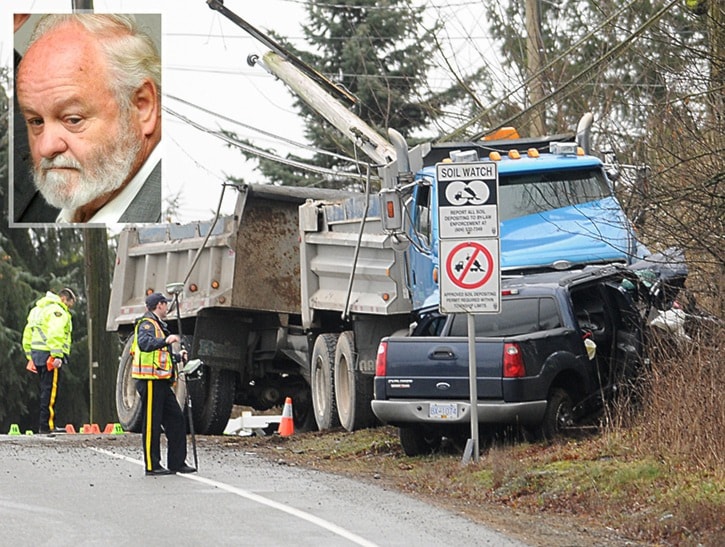When dump-truck driver Glen Edward Theriault crossed a double-yellow line nearly three years ago – ultimately killing a South Surrey man in a head-on collision – it was a "conscious, deliberate, risky decision," a Surrey Provincial Court judge said Friday.
"No reasonable person would even consider driving in the manner the accused did in this case," Judge Paul Dohm said prior to finding Theriault guilty of dangerous driving causing death in connection with the Jan. 18, 2011 crash that killed 59-year-old Jim Neiss.
"The accused deliberately drove dangerously. The only way the accused could not have seen (headlights of an oncoming vehicle) is if he didn't look at all."
Theriault, 65, has been on trial since mid-July. Friday's verdict was delivered on the 10th day of the proceedings, and brought Neiss's family and co-workers some consolation.
"I feel relief and vindicated," Brenda Michie, Neiss's widow, told Peace Arch News outside court. "The judge did an excellent, thorough job.
"I feel that justice has been served."
From the trial's outset, Theriault did not deny that he had driven his westbound truck – which was towing a pup trailer – into the eastbound lane of 16 Avenue over a double-yellow line on the morning in question.
The fatal maneuver, which began in the intersection at 200 Street, was an effort to pass two other westbound vehicles, said Dohm, recounting evidence heard over the course of the trial. When Theriault spotted Neiss's SUV, he braked and steered to the south side of the road. Neiss steered in the same direction, and the two hit head-on.
 The impact of Theriault's truck killed Neiss – who was on his way to work as a bus driver for Langley School District at the time – instantly and pushed his SUV 23 metres, Dohm said.
The impact of Theriault's truck killed Neiss – who was on his way to work as a bus driver for Langley School District at the time – instantly and pushed his SUV 23 metres, Dohm said.
At trial, Dohm heard from five witnesses who described seeing a dump truck being driven aggressively along 16 Avenue for several kilometres prior to the collision, which occurred just after 5:30 a.m. While a number of them testified they were sure it was the same truck that hit Neiss's – and "they are probably correct" – Dohm said he could not make that finding conclusively.
"It is not logically possible to link their evidence together in some cohesive fashion," he said. "I'm not able to find to the criminal standards of truth that this was the same dump truck throughout."
In finding Theriault guilty, Dohm said he relied on evidence regarding the accused's driving as seen from just east of 200 Street to the point of impact.
In reaching his verdict, he said he also did not consider "utterances" that Theriault had made to police in the hours immediately following the crash.
The court had heard that Theriault told a Langley RCMP officer that his decision to cross the double-yellow line that morning was a "bad, three-second mistake," and that he had believed at the time the road ahead was clear.
Following a voir dire to determine if Theriault's charter rights had been violated, Dohm had ruled the statements were admissible.
In explaining his reasoning for ultimately giving them no weight, Dohm noted video and factual evidence regarding the scene make it "very difficult to understand how the accused could've believed it was clear to pass."
"He only had a few seconds, at most, in darkness, to check whether it was clear."
Streetlights depicted in video taken of the roadway looking west look like two sets of headlights, Dohm said.
"I have decided this case without any regard to utterances found admissible in voir dire," he said.
Evidence Dohm found relevant included that the type of vehicle Theriault was driving would be more difficult to maneuver, take longer to stop and cause more damage in the event of a crash; that the driving behaviour occurred at a time when commuter and commercial traffic was starting to increase along 16 Avenue; that Theriault's speed was likely upwards of 75 km/h when he spotted Neiss; and that Theriault chose to ignore the risks associated with crossing a double-yellow line.
"Those lines indicate to a driver that passing is not permissible… not safe, even though that might not be readily apparent," Dohm said.
"A reasonably prudent driver would never have attempted to pass."
Prosecutor Winston Sayson told Peace Arch News the verdict was a "well-reasoned decision that confirms the Crown's submission that the driving of the accused was exceedingly dangerous."
Michie – who attended court with her sister Maureen Beales and Halimah Simon, one of Neiss's Langley School District co-workers – said Dohm's points covered "everything we felt."
She described her husband as "a colourful, opinionated person" who made her laugh everyday of the 20 years they were together.
"He'd be really pleased today," she said.
Simon said the verdict renews her faith in the justice system.
"I'll sleep good tonight," she said, adding Neiss's co-workers are "satisfied" with the trial's outcome.
Theriault did not speak to Peace Arch News, however, a woman who identified herself as his wife, agreed the situation has been difficult for all involved.
"Everybody's fractured," she said.
Sentencing is set for Feb. 14.

